ICT110: East Asia and Pacific Health and Population Data Report
VerifiedAdded on 2023/06/11
|22
|3497
|268
Report
AI Summary
This report analyzes health and population data from the East Asia and Pacific region, focusing on immunization and alcohol consumption. The analysis uses data from the World Bank to compare immunization rates and their relationship to health expenditure across countries, revealing variations in immunization coverage and a dispersed trend relative to health expenditure levels. It also examines the correlation between alcohol consumption and Gross National Income (GNI), finding no directly definable relationship. Advanced analysis includes hierarchical and K-means clustering of countries based on GNI, highlighting economic disparities within the region. Linear regression models are applied to explore the relationships between alcohol consumption and GNI, as well as immunization and health expenditure, providing insights into the factors influencing health outcomes and economic indicators in East Asia and the Pacific.

ANALYSIS OF EAST ASIA AND PACIFIC HEALTH AND POPULATION DATA
Paraphrase This Document
Need a fresh take? Get an instant paraphrase of this document with our AI Paraphraser
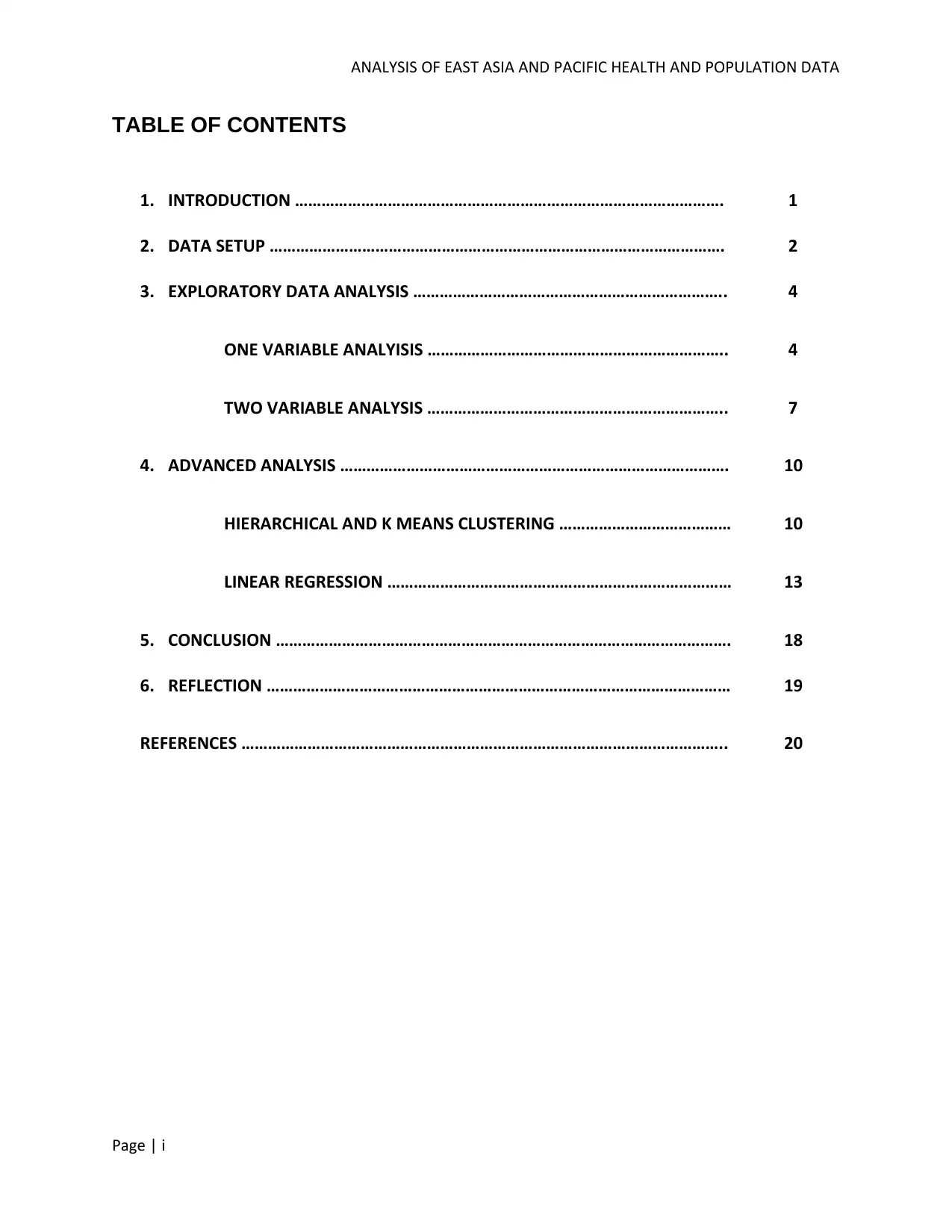
ANALYSIS OF EAST ASIA AND PACIFIC HEALTH AND POPULATION DATA
TABLE OF CONTENTS
1. INTRODUCTION ……………………………………………………………………………………. 1
2. DATA SETUP …………………………………………………………………………………………. 2
3. EXPLORATORY DATA ANALYSIS …………………………………………………………….. 4
ONE VARIABLE ANALYISIS ………………………………………………………….. 4
TWO VARIABLE ANALYSIS ………………………………………………………….. 7
4. ADVANCED ANALYSIS ……………………………………………………………………………. 10
HIERARCHICAL AND K MEANS CLUSTERING ………………………………… 10
LINEAR REGRESSION …………………………………………………………………… 13
5. CONCLUSION …………………………………………………………………………………………. 18
6. REFLECTION …………………………………………………………………………………………… 19
REFERENCES ……………………………………………………………………………………………….. 20
Page | i
TABLE OF CONTENTS
1. INTRODUCTION ……………………………………………………………………………………. 1
2. DATA SETUP …………………………………………………………………………………………. 2
3. EXPLORATORY DATA ANALYSIS …………………………………………………………….. 4
ONE VARIABLE ANALYISIS ………………………………………………………….. 4
TWO VARIABLE ANALYSIS ………………………………………………………….. 7
4. ADVANCED ANALYSIS ……………………………………………………………………………. 10
HIERARCHICAL AND K MEANS CLUSTERING ………………………………… 10
LINEAR REGRESSION …………………………………………………………………… 13
5. CONCLUSION …………………………………………………………………………………………. 18
6. REFLECTION …………………………………………………………………………………………… 19
REFERENCES ……………………………………………………………………………………………….. 20
Page | i

ANALYSIS OF EAST ASIA AND PACIFIC HEALTH AND POPULATION DATA
1. INTRODUCTION
This report represents the finding of the analysis on the data provided by the World
Bank on the Health and Population in the East Asia and Pacific region. The analysis focuses on
two main subsets in the data. These subsets are Immunization Data and Alcohol Consumption
Data.
Immunization is an important health care aspect in any country. This aspect determines
the survival rate of infants and children below five years of age. Polio, for instance, can develop
into a disease that affects an individual’s entire live. Investing in immunization drives, is
therefore a very important step in ensuring both the survival of the infants and children aged
five and below, and a healthy life. This report compares the immunization in countries in East
Asia and Pacific to obtain a view of the distribution of immunization among the populations in
East Asia and Pacific. This report also examines the relationship that exist between the
immunization and the amount of money allocated for health in the specific countries. The aim
for examining the relationship is to establish whether higher allocations for health mean a
higher allocation for immunization and if lower allocations for health mean lower allocation for
immunization. The findings will provide experts in the health sectors in the various countries
with information on the impact of investment in health to the immunization, information that
form a reliable basis for health planning and funding.
The report also relates alcohol consumption in East Asia and Pacific to the individual
income in each country. This comparison intends to establish whether the level of income has
any influence on the amount of alcohol consumption. This analysis first compares the alcohol
consumption and the Gross National Income (GNI) of the individual countries in East Asia and
Pacific. The comparisons will provide an understanding of the nature of each of the two
variables in the region. The outcome from this analysis will be relevant to researchers and
professionals interested in social data analysis.
Page | 1
1. INTRODUCTION
This report represents the finding of the analysis on the data provided by the World
Bank on the Health and Population in the East Asia and Pacific region. The analysis focuses on
two main subsets in the data. These subsets are Immunization Data and Alcohol Consumption
Data.
Immunization is an important health care aspect in any country. This aspect determines
the survival rate of infants and children below five years of age. Polio, for instance, can develop
into a disease that affects an individual’s entire live. Investing in immunization drives, is
therefore a very important step in ensuring both the survival of the infants and children aged
five and below, and a healthy life. This report compares the immunization in countries in East
Asia and Pacific to obtain a view of the distribution of immunization among the populations in
East Asia and Pacific. This report also examines the relationship that exist between the
immunization and the amount of money allocated for health in the specific countries. The aim
for examining the relationship is to establish whether higher allocations for health mean a
higher allocation for immunization and if lower allocations for health mean lower allocation for
immunization. The findings will provide experts in the health sectors in the various countries
with information on the impact of investment in health to the immunization, information that
form a reliable basis for health planning and funding.
The report also relates alcohol consumption in East Asia and Pacific to the individual
income in each country. This comparison intends to establish whether the level of income has
any influence on the amount of alcohol consumption. This analysis first compares the alcohol
consumption and the Gross National Income (GNI) of the individual countries in East Asia and
Pacific. The comparisons will provide an understanding of the nature of each of the two
variables in the region. The outcome from this analysis will be relevant to researchers and
professionals interested in social data analysis.
Page | 1
⊘ This is a preview!⊘
Do you want full access?
Subscribe today to unlock all pages.

Trusted by 1+ million students worldwide
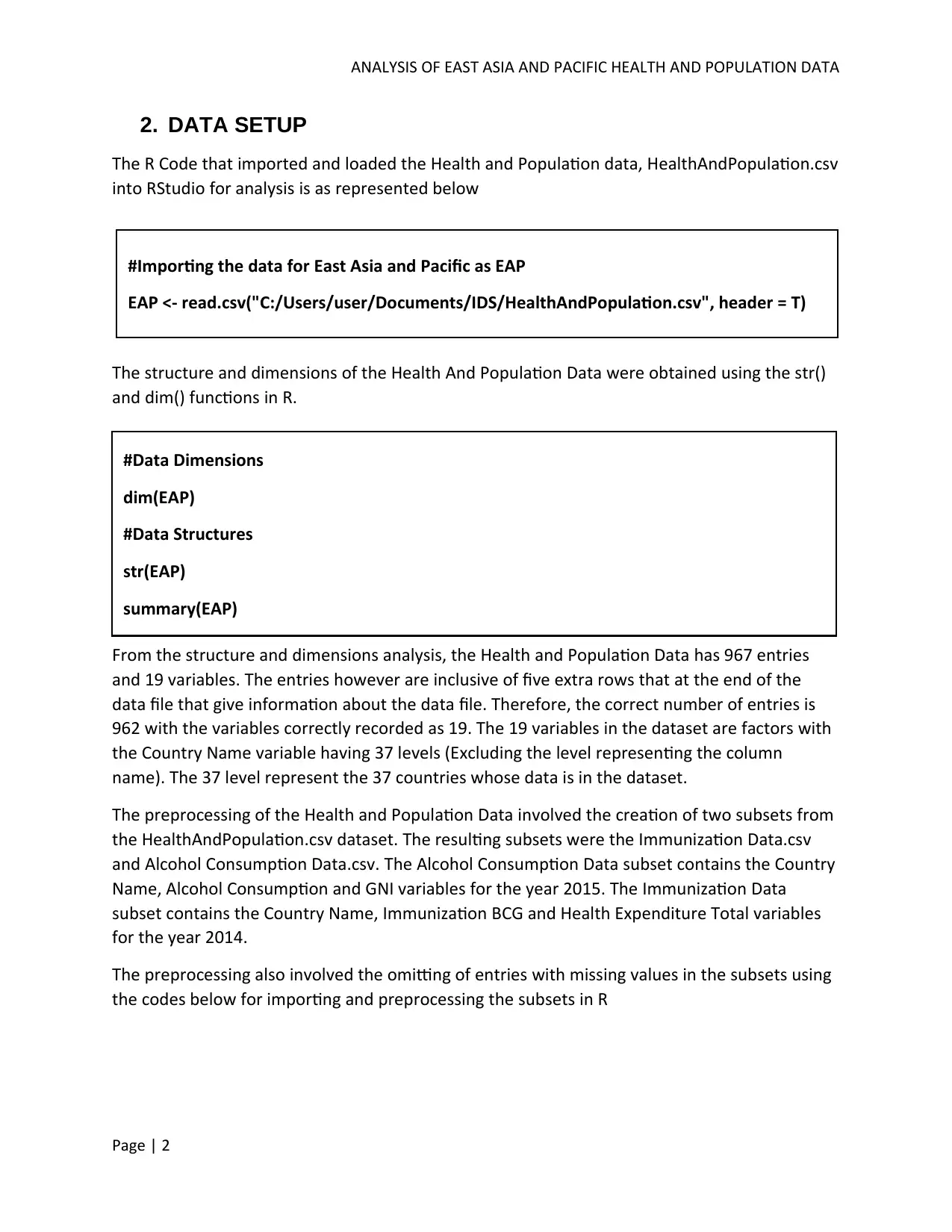
ANALYSIS OF EAST ASIA AND PACIFIC HEALTH AND POPULATION DATA
2. DATA SETUP
The R Code that imported and loaded the Health and Population data, HealthAndPopulation.csv
into RStudio for analysis is as represented below
The structure and dimensions of the Health And Population Data were obtained using the str()
and dim() functions in R.
From the structure and dimensions analysis, the Health and Population Data has 967 entries
and 19 variables. The entries however are inclusive of five extra rows that at the end of the
data file that give information about the data file. Therefore, the correct number of entries is
962 with the variables correctly recorded as 19. The 19 variables in the dataset are factors with
the Country Name variable having 37 levels (Excluding the level representing the column
name). The 37 level represent the 37 countries whose data is in the dataset.
The preprocessing of the Health and Population Data involved the creation of two subsets from
the HealthAndPopulation.csv dataset. The resulting subsets were the Immunization Data.csv
and Alcohol Consumption Data.csv. The Alcohol Consumption Data subset contains the Country
Name, Alcohol Consumption and GNI variables for the year 2015. The Immunization Data
subset contains the Country Name, Immunization BCG and Health Expenditure Total variables
for the year 2014.
The preprocessing also involved the omitting of entries with missing values in the subsets using
the codes below for importing and preprocessing the subsets in R
Page | 2
#Importing the data for East Asia and Pacific as EAP
EAP <- read.csv("C:/Users/user/Documents/IDS/HealthAndPopulation.csv", header = T)
#Data Dimensions
dim(EAP)
#Data Structures
str(EAP)
summary(EAP)
2. DATA SETUP
The R Code that imported and loaded the Health and Population data, HealthAndPopulation.csv
into RStudio for analysis is as represented below
The structure and dimensions of the Health And Population Data were obtained using the str()
and dim() functions in R.
From the structure and dimensions analysis, the Health and Population Data has 967 entries
and 19 variables. The entries however are inclusive of five extra rows that at the end of the
data file that give information about the data file. Therefore, the correct number of entries is
962 with the variables correctly recorded as 19. The 19 variables in the dataset are factors with
the Country Name variable having 37 levels (Excluding the level representing the column
name). The 37 level represent the 37 countries whose data is in the dataset.
The preprocessing of the Health and Population Data involved the creation of two subsets from
the HealthAndPopulation.csv dataset. The resulting subsets were the Immunization Data.csv
and Alcohol Consumption Data.csv. The Alcohol Consumption Data subset contains the Country
Name, Alcohol Consumption and GNI variables for the year 2015. The Immunization Data
subset contains the Country Name, Immunization BCG and Health Expenditure Total variables
for the year 2014.
The preprocessing also involved the omitting of entries with missing values in the subsets using
the codes below for importing and preprocessing the subsets in R
Page | 2
#Importing the data for East Asia and Pacific as EAP
EAP <- read.csv("C:/Users/user/Documents/IDS/HealthAndPopulation.csv", header = T)
#Data Dimensions
dim(EAP)
#Data Structures
str(EAP)
summary(EAP)
Paraphrase This Document
Need a fresh take? Get an instant paraphrase of this document with our AI Paraphraser
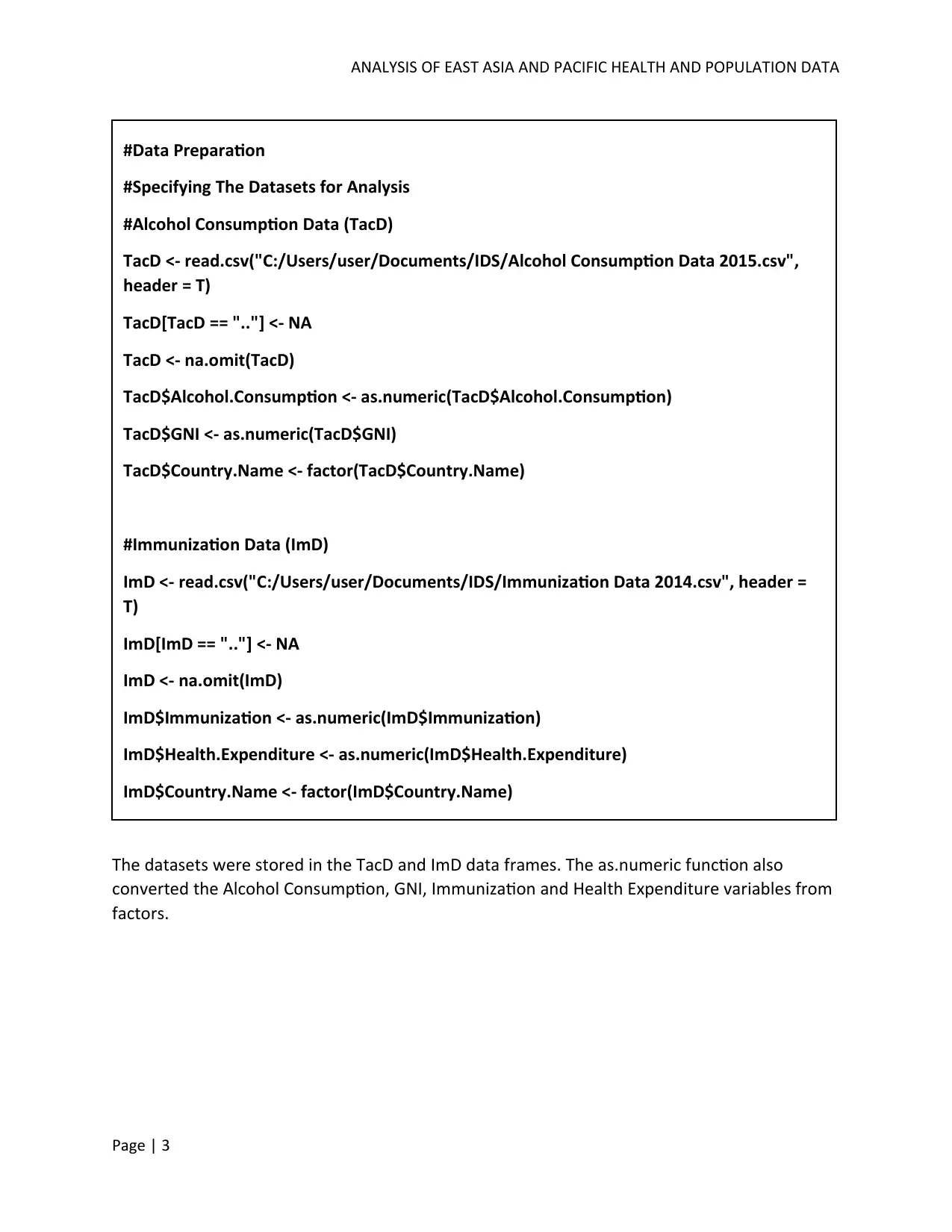
ANALYSIS OF EAST ASIA AND PACIFIC HEALTH AND POPULATION DATA
The datasets were stored in the TacD and ImD data frames. The as.numeric function also
converted the Alcohol Consumption, GNI, Immunization and Health Expenditure variables from
factors.
Page | 3
#Data Preparation
#Specifying The Datasets for Analysis
#Alcohol Consumption Data (TacD)
TacD <- read.csv("C:/Users/user/Documents/IDS/Alcohol Consumption Data 2015.csv",
header = T)
TacD[TacD == ".."] <- NA
TacD <- na.omit(TacD)
TacD$Alcohol.Consumption <- as.numeric(TacD$Alcohol.Consumption)
TacD$GNI <- as.numeric(TacD$GNI)
TacD$Country.Name <- factor(TacD$Country.Name)
#Immunization Data (ImD)
ImD <- read.csv("C:/Users/user/Documents/IDS/Immunization Data 2014.csv", header =
T)
ImD[ImD == ".."] <- NA
ImD <- na.omit(ImD)
ImD$Immunization <- as.numeric(ImD$Immunization)
ImD$Health.Expenditure <- as.numeric(ImD$Health.Expenditure)
ImD$Country.Name <- factor(ImD$Country.Name)
The datasets were stored in the TacD and ImD data frames. The as.numeric function also
converted the Alcohol Consumption, GNI, Immunization and Health Expenditure variables from
factors.
Page | 3
#Data Preparation
#Specifying The Datasets for Analysis
#Alcohol Consumption Data (TacD)
TacD <- read.csv("C:/Users/user/Documents/IDS/Alcohol Consumption Data 2015.csv",
header = T)
TacD[TacD == ".."] <- NA
TacD <- na.omit(TacD)
TacD$Alcohol.Consumption <- as.numeric(TacD$Alcohol.Consumption)
TacD$GNI <- as.numeric(TacD$GNI)
TacD$Country.Name <- factor(TacD$Country.Name)
#Immunization Data (ImD)
ImD <- read.csv("C:/Users/user/Documents/IDS/Immunization Data 2014.csv", header =
T)
ImD[ImD == ".."] <- NA
ImD <- na.omit(ImD)
ImD$Immunization <- as.numeric(ImD$Immunization)
ImD$Health.Expenditure <- as.numeric(ImD$Health.Expenditure)
ImD$Country.Name <- factor(ImD$Country.Name)
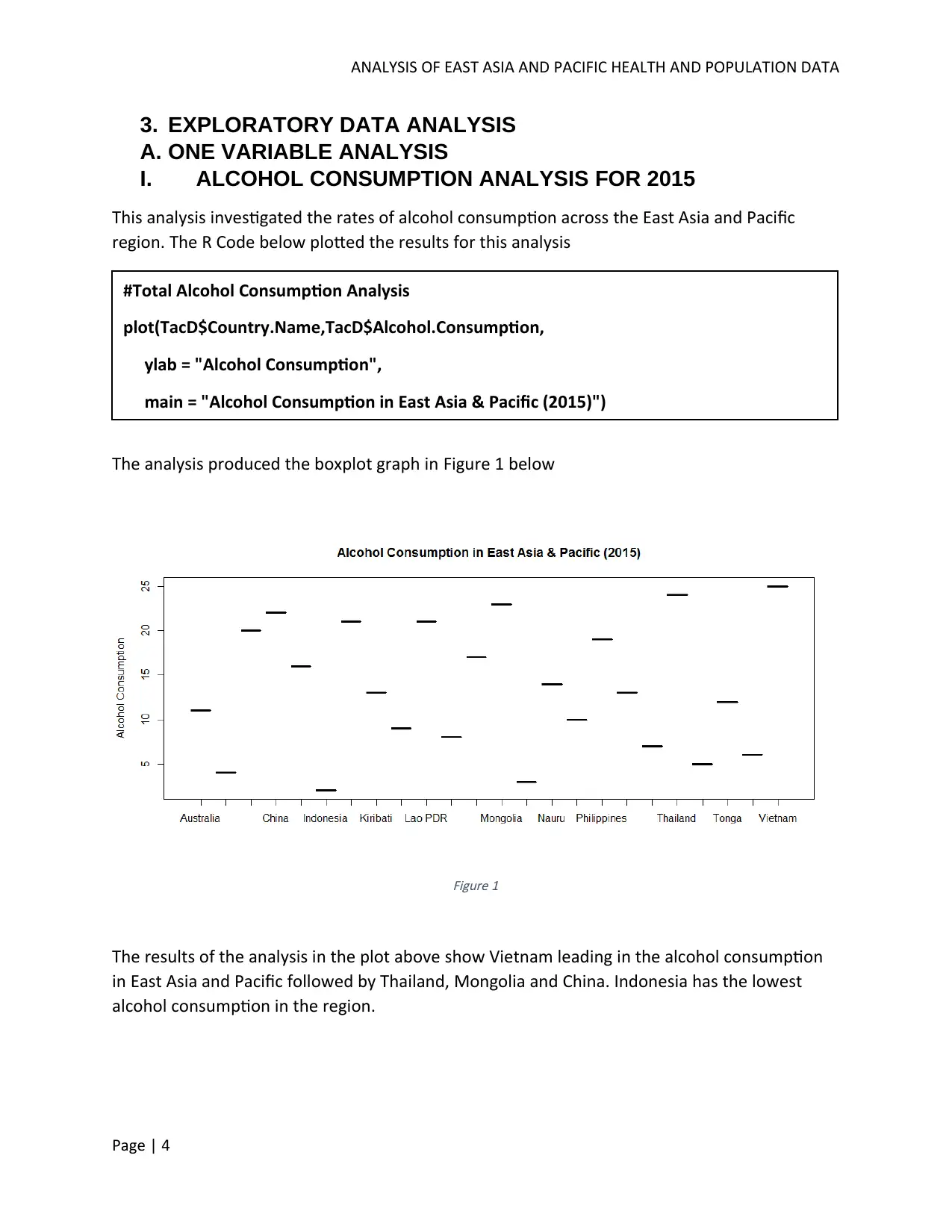
ANALYSIS OF EAST ASIA AND PACIFIC HEALTH AND POPULATION DATA
3. EXPLORATORY DATA ANALYSIS
A. ONE VARIABLE ANALYSIS
I. ALCOHOL CONSUMPTION ANALYSIS FOR 2015
This analysis investigated the rates of alcohol consumption across the East Asia and Pacific
region. The R Code below plotted the results for this analysis
The analysis produced the boxplot graph in Figure 1 below
Figure 1
The results of the analysis in the plot above show Vietnam leading in the alcohol consumption
in East Asia and Pacific followed by Thailand, Mongolia and China. Indonesia has the lowest
alcohol consumption in the region.
Page | 4
#Total Alcohol Consumption Analysis
plot(TacD$Country.Name,TacD$Alcohol.Consumption,
ylab = "Alcohol Consumption",
main = "Alcohol Consumption in East Asia & Pacific (2015)")
3. EXPLORATORY DATA ANALYSIS
A. ONE VARIABLE ANALYSIS
I. ALCOHOL CONSUMPTION ANALYSIS FOR 2015
This analysis investigated the rates of alcohol consumption across the East Asia and Pacific
region. The R Code below plotted the results for this analysis
The analysis produced the boxplot graph in Figure 1 below
Figure 1
The results of the analysis in the plot above show Vietnam leading in the alcohol consumption
in East Asia and Pacific followed by Thailand, Mongolia and China. Indonesia has the lowest
alcohol consumption in the region.
Page | 4
#Total Alcohol Consumption Analysis
plot(TacD$Country.Name,TacD$Alcohol.Consumption,
ylab = "Alcohol Consumption",
main = "Alcohol Consumption in East Asia & Pacific (2015)")
⊘ This is a preview!⊘
Do you want full access?
Subscribe today to unlock all pages.

Trusted by 1+ million students worldwide
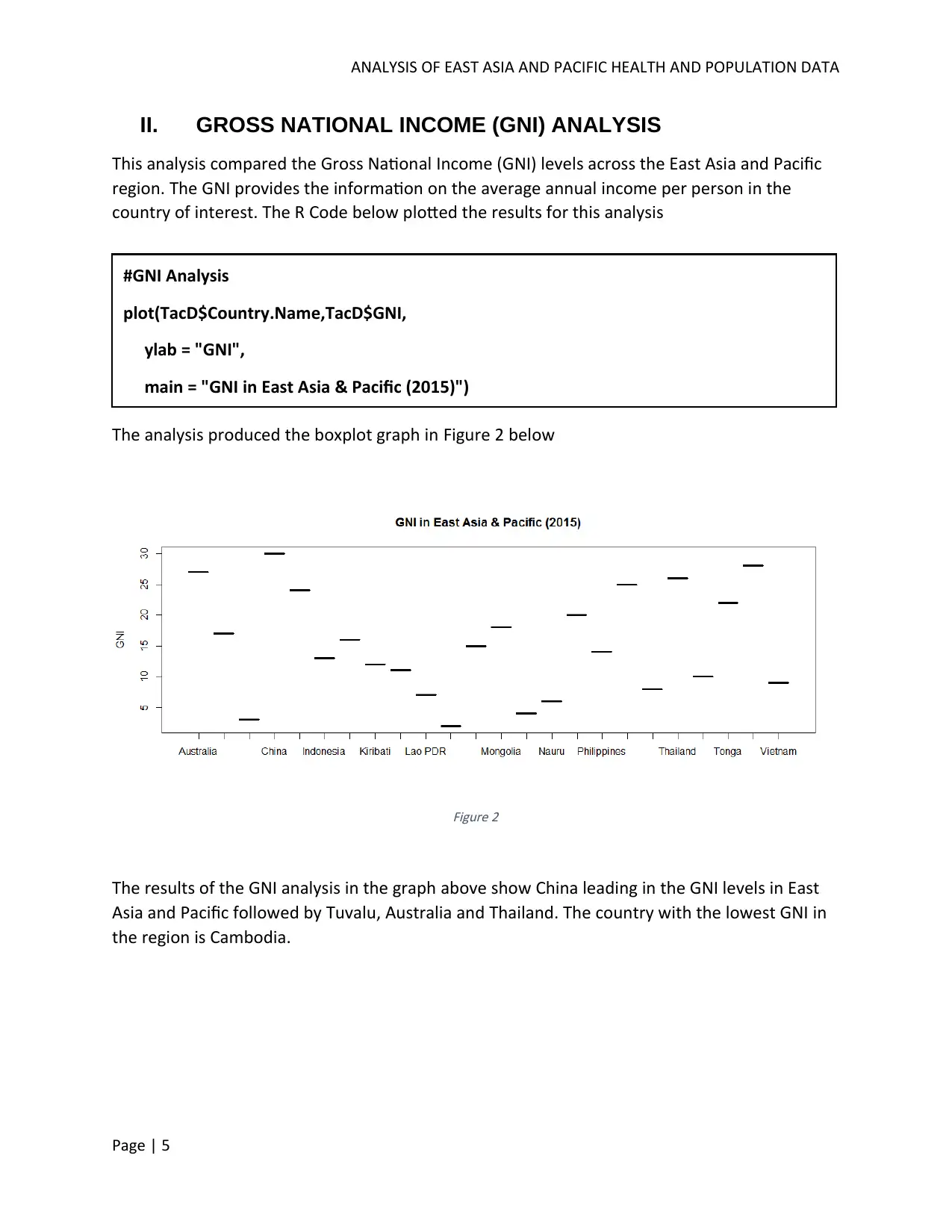
ANALYSIS OF EAST ASIA AND PACIFIC HEALTH AND POPULATION DATA
II. GROSS NATIONAL INCOME (GNI) ANALYSIS
This analysis compared the Gross National Income (GNI) levels across the East Asia and Pacific
region. The GNI provides the information on the average annual income per person in the
country of interest. The R Code below plotted the results for this analysis
The analysis produced the boxplot graph in Figure 2 below
Figure 2
The results of the GNI analysis in the graph above show China leading in the GNI levels in East
Asia and Pacific followed by Tuvalu, Australia and Thailand. The country with the lowest GNI in
the region is Cambodia.
Page | 5
#GNI Analysis
plot(TacD$Country.Name,TacD$GNI,
ylab = "GNI",
main = "GNI in East Asia & Pacific (2015)")
II. GROSS NATIONAL INCOME (GNI) ANALYSIS
This analysis compared the Gross National Income (GNI) levels across the East Asia and Pacific
region. The GNI provides the information on the average annual income per person in the
country of interest. The R Code below plotted the results for this analysis
The analysis produced the boxplot graph in Figure 2 below
Figure 2
The results of the GNI analysis in the graph above show China leading in the GNI levels in East
Asia and Pacific followed by Tuvalu, Australia and Thailand. The country with the lowest GNI in
the region is Cambodia.
Page | 5
#GNI Analysis
plot(TacD$Country.Name,TacD$GNI,
ylab = "GNI",
main = "GNI in East Asia & Pacific (2015)")
Paraphrase This Document
Need a fresh take? Get an instant paraphrase of this document with our AI Paraphraser
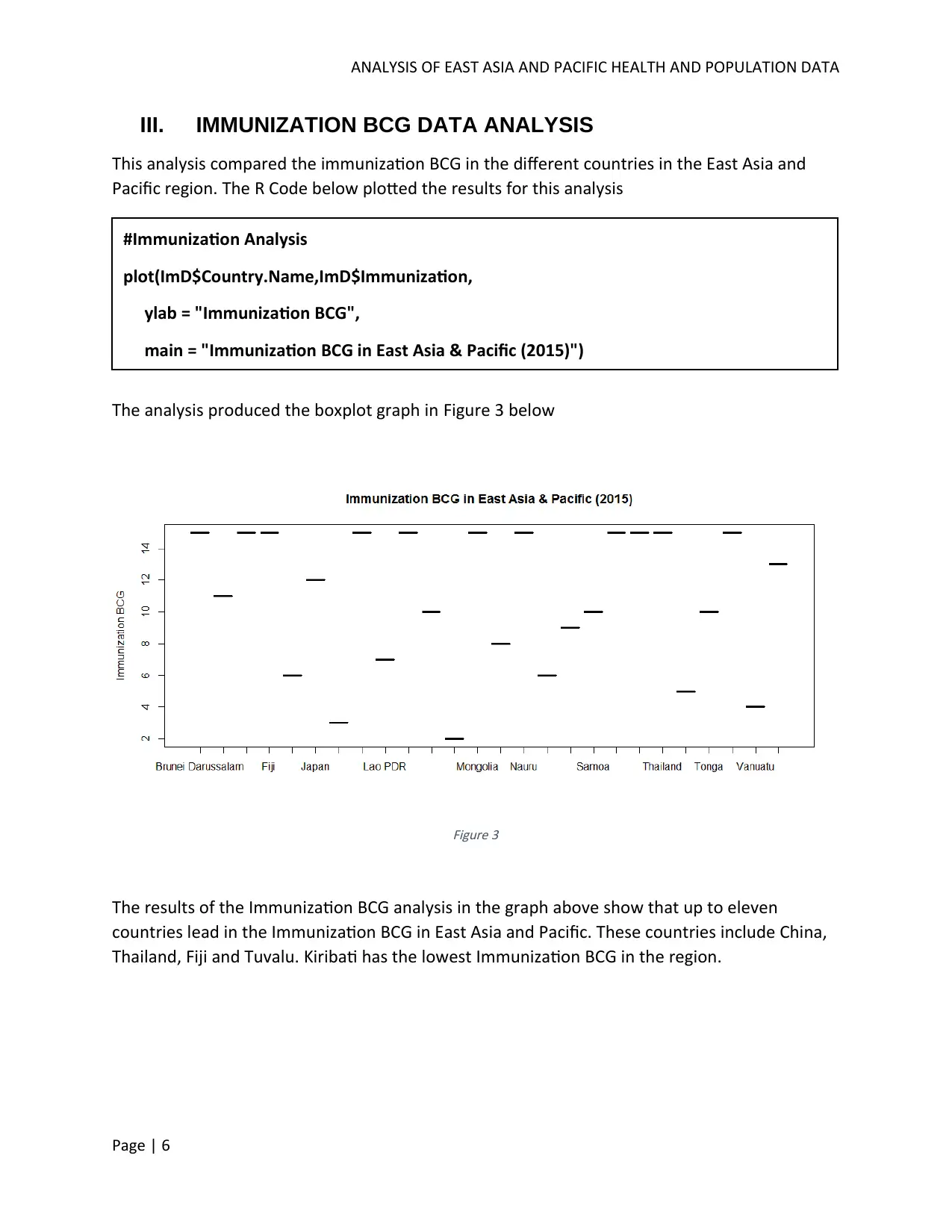
ANALYSIS OF EAST ASIA AND PACIFIC HEALTH AND POPULATION DATA
III. IMMUNIZATION BCG DATA ANALYSIS
This analysis compared the immunization BCG in the different countries in the East Asia and
Pacific region. The R Code below plotted the results for this analysis
The analysis produced the boxplot graph in Figure 3 below
Figure 3
The results of the Immunization BCG analysis in the graph above show that up to eleven
countries lead in the Immunization BCG in East Asia and Pacific. These countries include China,
Thailand, Fiji and Tuvalu. Kiribati has the lowest Immunization BCG in the region.
Page | 6
#Immunization Analysis
plot(ImD$Country.Name,ImD$Immunization,
ylab = "Immunization BCG",
main = "Immunization BCG in East Asia & Pacific (2015)")
III. IMMUNIZATION BCG DATA ANALYSIS
This analysis compared the immunization BCG in the different countries in the East Asia and
Pacific region. The R Code below plotted the results for this analysis
The analysis produced the boxplot graph in Figure 3 below
Figure 3
The results of the Immunization BCG analysis in the graph above show that up to eleven
countries lead in the Immunization BCG in East Asia and Pacific. These countries include China,
Thailand, Fiji and Tuvalu. Kiribati has the lowest Immunization BCG in the region.
Page | 6
#Immunization Analysis
plot(ImD$Country.Name,ImD$Immunization,
ylab = "Immunization BCG",
main = "Immunization BCG in East Asia & Pacific (2015)")

ANALYSIS OF EAST ASIA AND PACIFIC HEALTH AND POPULATION DATA
B. TWO VARIABLE ANALYSIS
I. ALCOHOL CONSUMPTION - GROSS NATIONAL INCOME
(GNI) ANALYSIS
This analysis examined the relationship between the alcohol consumption and the Gross
National Income in East Asia and Pacific. The R Code below plotted the outcome of the analysis
The analysis produced the scatterplot in Figure 4 below
Figure 4
The results in the plot above does not show any directly definable relationship between the
Alcohol Consumption and the GNI in the East Asia and Pacific Region.
Page | 7
#Alcohol Consumption Data Analysis
plot(TacD$GNI,TacD$Alcohol.Consumption,
xlab = "GNI", ylab = "Alcohol Consumption",
main = "Alcohol Consumption - GNI Analysis in East Asia & Pacific")
B. TWO VARIABLE ANALYSIS
I. ALCOHOL CONSUMPTION - GROSS NATIONAL INCOME
(GNI) ANALYSIS
This analysis examined the relationship between the alcohol consumption and the Gross
National Income in East Asia and Pacific. The R Code below plotted the outcome of the analysis
The analysis produced the scatterplot in Figure 4 below
Figure 4
The results in the plot above does not show any directly definable relationship between the
Alcohol Consumption and the GNI in the East Asia and Pacific Region.
Page | 7
#Alcohol Consumption Data Analysis
plot(TacD$GNI,TacD$Alcohol.Consumption,
xlab = "GNI", ylab = "Alcohol Consumption",
main = "Alcohol Consumption - GNI Analysis in East Asia & Pacific")
⊘ This is a preview!⊘
Do you want full access?
Subscribe today to unlock all pages.

Trusted by 1+ million students worldwide
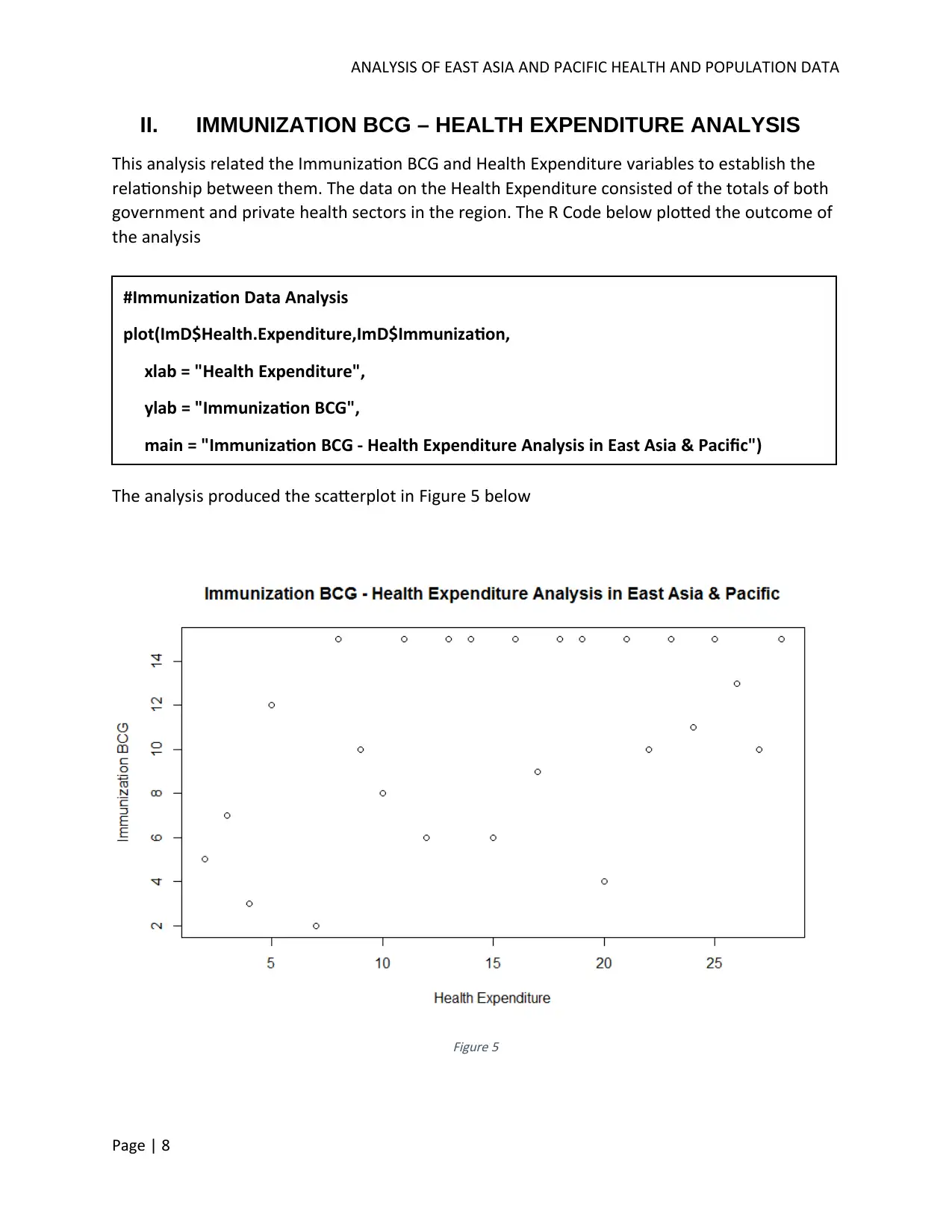
ANALYSIS OF EAST ASIA AND PACIFIC HEALTH AND POPULATION DATA
II. IMMUNIZATION BCG – HEALTH EXPENDITURE ANALYSIS
This analysis related the Immunization BCG and Health Expenditure variables to establish the
relationship between them. The data on the Health Expenditure consisted of the totals of both
government and private health sectors in the region. The R Code below plotted the outcome of
the analysis
The analysis produced the scatterplot in Figure 5 below
Figure 5
Page | 8
#Immunization Data Analysis
plot(ImD$Health.Expenditure,ImD$Immunization,
xlab = "Health Expenditure",
ylab = "Immunization BCG",
main = "Immunization BCG - Health Expenditure Analysis in East Asia & Pacific")
II. IMMUNIZATION BCG – HEALTH EXPENDITURE ANALYSIS
This analysis related the Immunization BCG and Health Expenditure variables to establish the
relationship between them. The data on the Health Expenditure consisted of the totals of both
government and private health sectors in the region. The R Code below plotted the outcome of
the analysis
The analysis produced the scatterplot in Figure 5 below
Figure 5
Page | 8
#Immunization Data Analysis
plot(ImD$Health.Expenditure,ImD$Immunization,
xlab = "Health Expenditure",
ylab = "Immunization BCG",
main = "Immunization BCG - Health Expenditure Analysis in East Asia & Pacific")
Paraphrase This Document
Need a fresh take? Get an instant paraphrase of this document with our AI Paraphraser
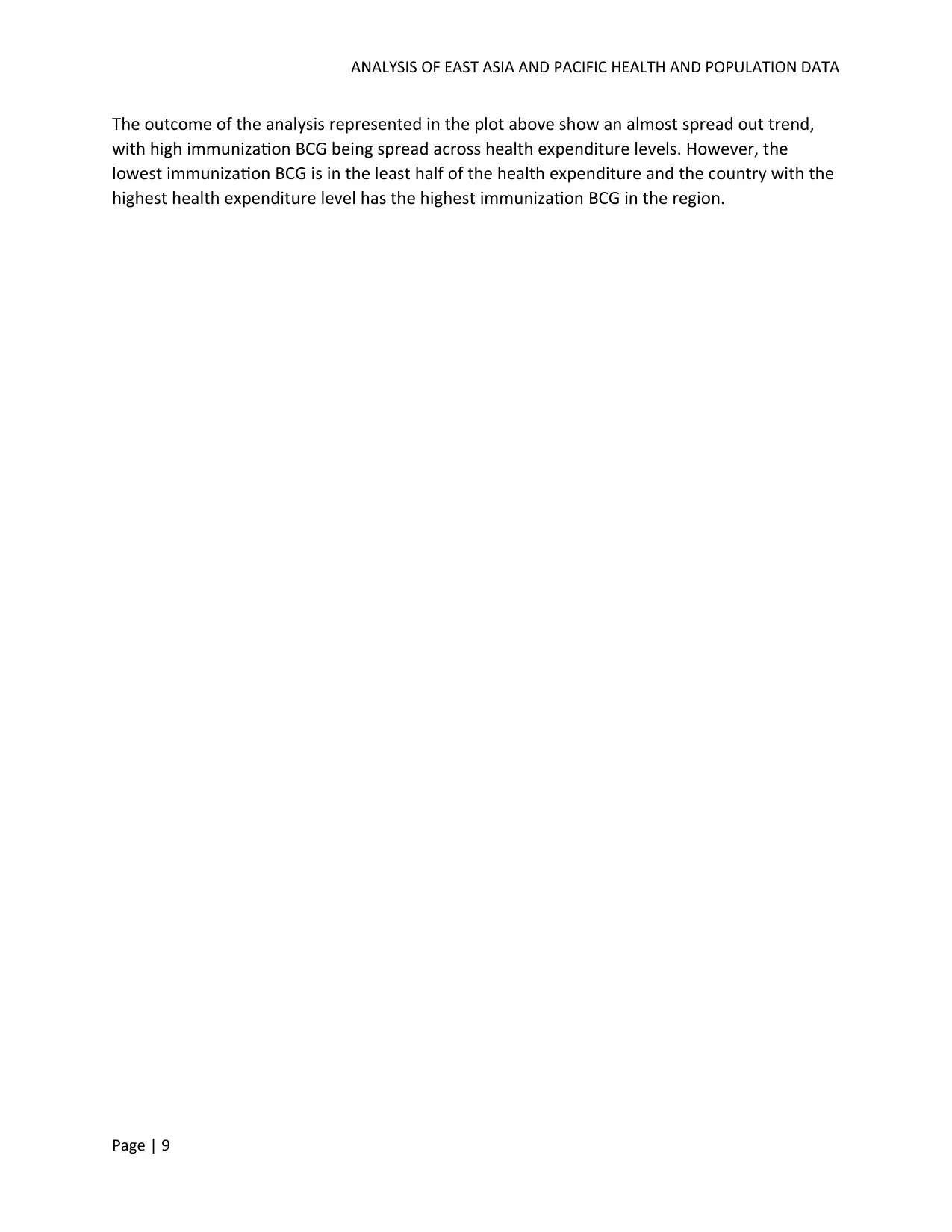
ANALYSIS OF EAST ASIA AND PACIFIC HEALTH AND POPULATION DATA
The outcome of the analysis represented in the plot above show an almost spread out trend,
with high immunization BCG being spread across health expenditure levels. However, the
lowest immunization BCG is in the least half of the health expenditure and the country with the
highest health expenditure level has the highest immunization BCG in the region.
Page | 9
The outcome of the analysis represented in the plot above show an almost spread out trend,
with high immunization BCG being spread across health expenditure levels. However, the
lowest immunization BCG is in the least half of the health expenditure and the country with the
highest health expenditure level has the highest immunization BCG in the region.
Page | 9

ANALYSIS OF EAST ASIA AND PACIFIC HEALTH AND POPULATION DATA
4. ADVANCED ANALYSIS
A. HIERARCHICAL AND K MEANS CLUSTER ANALYSIS
Clustering group together items that are similar in a dataset based on a predetermined
condition or attribute (Galit, et al., 2018). It investigates the relationships and the nature of the
data in multivariate data sets (Jon, 2006). This cluster analysis focused on the Gross National
Income (GNI) in East Asia and Pacific region for the year 2015. The analysis aimed at grouping
the countries in the region according to their GNI levels. The GNI, as an economic indicator,
gives a view of how the economies in the region compare and relate.
The R Code below produced the plot for the hierarchical cluster analysis
The analysis produced the plot in Figure 6 below
Figure 6
Page | 10
#Hierarchical Cluster plot for GNI in 2015
Hclust <- hclust(dist(TacD[,c(1,3)]))
plot(Hclust, labels = TacD$Country.Name,
ylab = "GNI",
main = "GNI EAST ASIA & PACIFIC 2015")
4. ADVANCED ANALYSIS
A. HIERARCHICAL AND K MEANS CLUSTER ANALYSIS
Clustering group together items that are similar in a dataset based on a predetermined
condition or attribute (Galit, et al., 2018). It investigates the relationships and the nature of the
data in multivariate data sets (Jon, 2006). This cluster analysis focused on the Gross National
Income (GNI) in East Asia and Pacific region for the year 2015. The analysis aimed at grouping
the countries in the region according to their GNI levels. The GNI, as an economic indicator,
gives a view of how the economies in the region compare and relate.
The R Code below produced the plot for the hierarchical cluster analysis
The analysis produced the plot in Figure 6 below
Figure 6
Page | 10
#Hierarchical Cluster plot for GNI in 2015
Hclust <- hclust(dist(TacD[,c(1,3)]))
plot(Hclust, labels = TacD$Country.Name,
ylab = "GNI",
main = "GNI EAST ASIA & PACIFIC 2015")
⊘ This is a preview!⊘
Do you want full access?
Subscribe today to unlock all pages.

Trusted by 1+ million students worldwide
1 out of 22
Related Documents
Your All-in-One AI-Powered Toolkit for Academic Success.
+13062052269
info@desklib.com
Available 24*7 on WhatsApp / Email
![[object Object]](/_next/static/media/star-bottom.7253800d.svg)
Unlock your academic potential
Copyright © 2020–2026 A2Z Services. All Rights Reserved. Developed and managed by ZUCOL.




